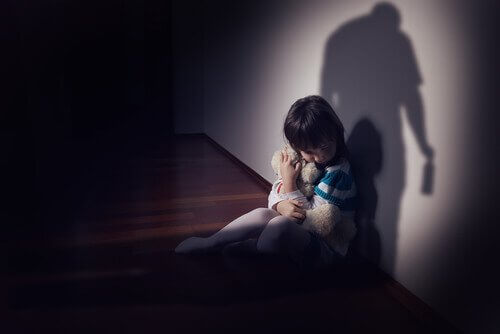How Does an Aggressor's Personality Develop?

Aggression results in many injuries and deaths, which is why it’s important to continue investigating how aggression develops. Thus, understanding how violence manifests in a relationship, and in other areas, involves knowing how an aggressor’s personality develops. We must also understand how they experience their relationships.
Research data shows that being a victim of or witnessing violence doesn’t necessarily mean you’ll be violent in the future. However, studies also tell us that many aggressors do have a history of family violence (54%).
An aggressor’s personality develops in childhood and adolescence
Attachment is the way we connect to the world, especially to emotional figures. From a young age, our attachment system activates in the face of any threat. So when we face fear, we look for the sense of security offered by our emotional figures, our parents for example.
On the other hand, this energy can sometimes transform into aggression. In this case, violence has the purpose of drawing the attention of the emotional figure so that they can help.

It seems that borderline and antisocial aggressors in particular have an insecure attachment that characterizes their way of bonding with emotional figures. When this type of insecure attachment is combined with an exposure to violence, humiliation, and detachment, it can lead to a personality disorder and violent behavior.
According to Dutton (2003), these factors mixed together result in a “diffuse identity”. In these cases, violence and emotional distancing feed a vicious circle that destroys relationships.
What kind of background do aggressors have?
As we know, our experiences with our emotional figures help to determine our personalities. According to Dutton (2003), there are many precedents regarding aggressors’ family experiences and the psychological and physical episodes that produce them:
- Rejection and humiliation: Low self-esteem, anger, blaming external factors, lack of emotional regulation, and the tendency to frequently be violent and mistreat others emotionally, among others.
- Insecure attachment: They have a lot of jealousy and rage and want control.
- Victim and/or witness of physical abuse: They have memories of patterns of violence, don’t have positive problem-solving strategies, have low empathy for victims of violence, and they tend to abuse, among others.
- Rejection, humiliation, and insecure attachment: Violence is central in their intimate relationships.
- Rejection, humiliation, insecure attachment, and victim and/or witness of physical abuse: The integrity of their ego depends on the relationship so they control, mistreat and persecute.
Thus, the aggressor’s fear of abandonment provokes their need to control and harm the victim.
The role of values when it comes to violence
A young person with insecure attachment develops a values system that justifies how they see the world. Therefore, it also justifies the relationships they have with their partners. These values are transmitted through their family, peer groups, school, movies, etc. The main values that are related to domestic violence include:
- Male superiority: The Superman myth, the man as the provider, tolerance of male promiscuity, relationship control, the right to demand domestic services from their partner, among others.
- Way of understanding violence: A bad mood causes violence, men are jealous by nature, breaking things isn’t aggression, and sometimes there are no other alternatives, among others.
- How they see women: Women are manipulative and see men as money sources, feminists hate men, and women like to be dominated or are as violent as men, among others.
Why aggressors resort to domestic violence
According to Holma et al. (2006), aggressors justify their violence in six ways:
- They believe violence is natural.
- Violence is related to an aggressor’s inability to manage some difficult situations.
- The aggressors believe they were cornered.
- Their partner had upset them.
- They temporarily lost control.
- The use their traumatic past or stress to justify themselves.
It’s important to keep in mind that it’s not about winning a battle against the aggressor. It’s about doing what’s best for you. All violence is negative.
When a victim who suffers from violence seeks help, the professionals seek to boost their self-esteem and self-confidence so they can feel in control of their lives again.
This text is provided for informational purposes only and does not replace consultation with a professional. If in doubt, consult your specialist.








